If you read the two volumes entitled " Histoire du Séminaire de Saint-Hyacinthe depuis sa fondation jusqu'à nos jours : 1811 un siècle 1911 ", who were written by Mgr Charles-Philippe Choquette (1856-1947), you could discover some mere details about the library. Here is some of them :
In 1825, Mgr Jean-Jacques Lartigue (1777-1840), the first Bishop of Montreal, was writing in his multiple correspondence that the library collection of the Seminary of Saint-Hyacinthe was composed of 450 titles. At this time, it was good in regard of the means available.
In 1866, it was reported that the Seminary, has received the legacy of the abbot Jean Olivier Chèvrefils (1790-1833) that was containing ; 729 books, 14 maps et 65 engravings. This legacy represented at that time, one of the largest private library owned in Lower Canada.
In 1878, a letter from the Father Superior of this epoch reports that the library was situated in the room in front of his own bedroom. The library was remodeled during some constructions projects. Its room was enlarged by destroying many rooms used by the Father Bursar, the Father Assistant Director, the maids, and the kitchen's staircase. The only architectural details described by Mgr Choquette, was about the ceiling's ornaments installed in 1901.
In 1911, during the Seminary's centenary feasts, the Fathers anounced that they will build a new library. They will have to destroy the physics room, the chemistry laboratory and the museums rooms. Meanwhile, to maintain library services to the students, they create smalls libraries of few shelves containing some hundreds books in each Rhetoric and Belles-Lettres classrooms.
Here are 5 photos showing the library from 1911 to 1927. The black and white photographies are from the archivals files of the Seminary of Saint-Hyacinthe which is managed by the Centre d'histoire de Saint-Hyacinthe:
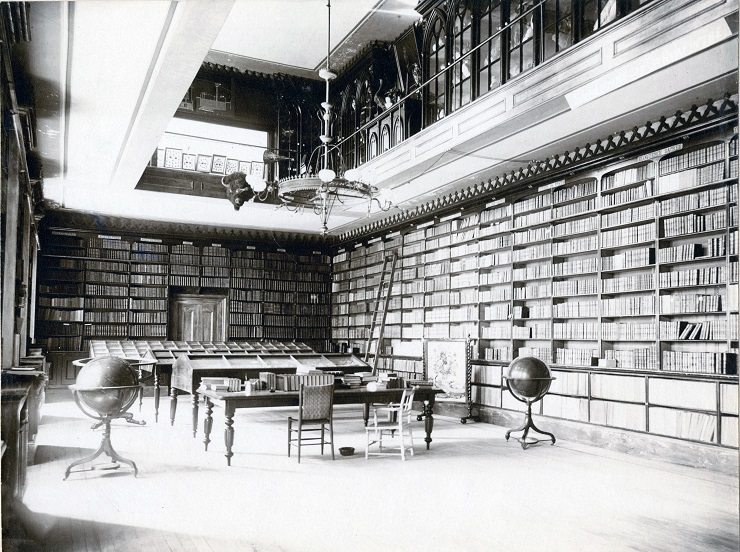
This is showing the section reserved to the books of the library
and
to display some artifacts about the natural history collections
from 1911 to 1927.
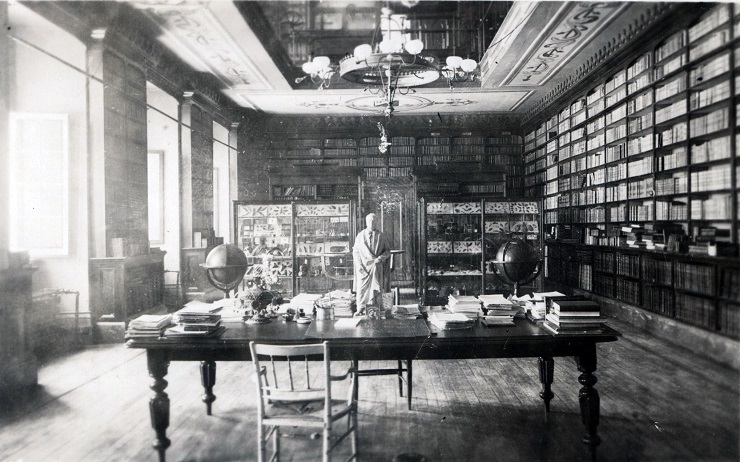
View of the other side of the section reserved to the books of the library
and
to display some artifacts about the natural history collections
from 1911 to 1927.
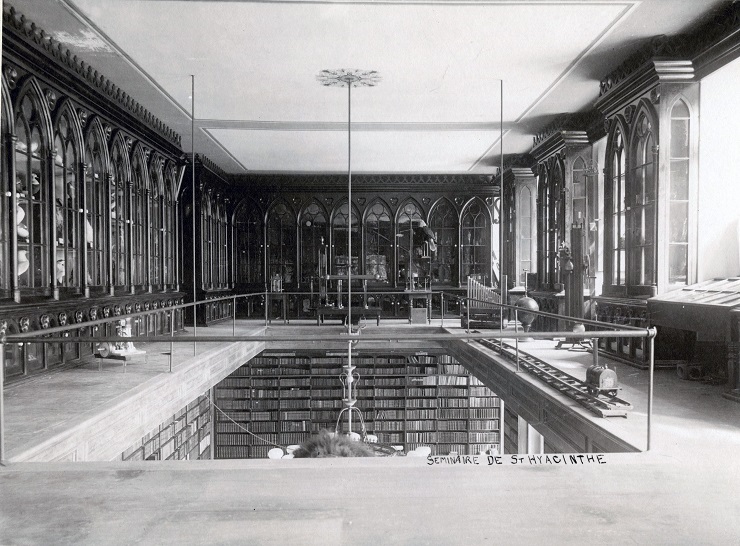
View on the mezzanine of the sections reserved to the museum, to
the physic and chemistry laboratories equipments,
and to some artifacts about the natural history collections from 1911 to 1927.
The great cabinets on the side of the mezzanine were used to store the physic
and chemistry laboratories equipments.
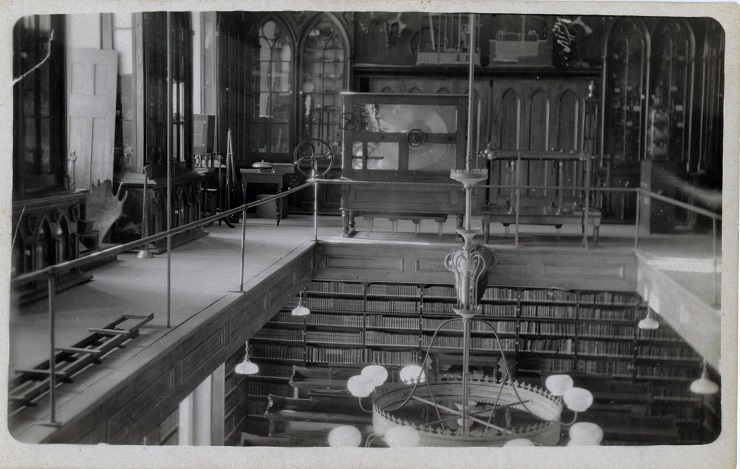
View on the mezzanine of the sections reserved to the museum, to
the physic and chemistry laboratories equipments,
and to some artifacts about the natural history collections from 1911 to 1927.
In the middle, we could see a rectangular apparatus with glass sides
which was used to study radiography by the professor Mgr Charles-Philippe Choquette.
This radiographic apparatus is still displayed at the Seminary.
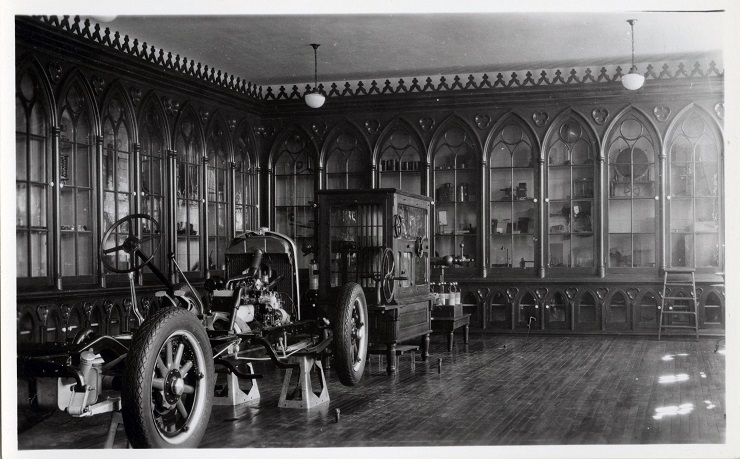
View on the other side of the mezzanine of the sections reserved to
the museum, to the physic and chemistry laboratories equipments,
and to some artifacts about the natural history collections from 1911 to 1927.
You could see an old car and the radiographic apparatus which was used to study
radiography by the professor Mgr Charles-Philippe Choquette.
In 1927, during the demolition of the ancient chapell which was created in 1884, by the architect, M. Adolphe Lévesque, a fire destroyed the students dormitory wing of the Seminary. Then, the administrators and the Superior of the Seminary, decide to modify the South wing where was the library. This wing of the building will be destroyed and the architect, Mr René Richer, who was in charge of the construction of the new chapell, received the mandate to create and supervise all these projects on the construction of two wings of an height of four floors and of a width of 100 feet (30,48 meters). The Seminary's administration wanted that they could have the water laid on, the sewer system, the electricity and a central heating system for all the wings of the building. The architect has also the mandate of building in a way very strong and fireproof. The new library was then installed on the actual site occupied on the ground level of the South wing. Since 1929, the library occupies half of the ground level of the South wing.
Here are 5 photos showing the library from 1927 to today. The black and white photographies are from the archivals files of the Seminary of Saint-Hyacinthe which is managed by the Centre d'histoire de Saint-Hyacinthe , the color photographies were made by the librarian, Mr Bernard Auger :
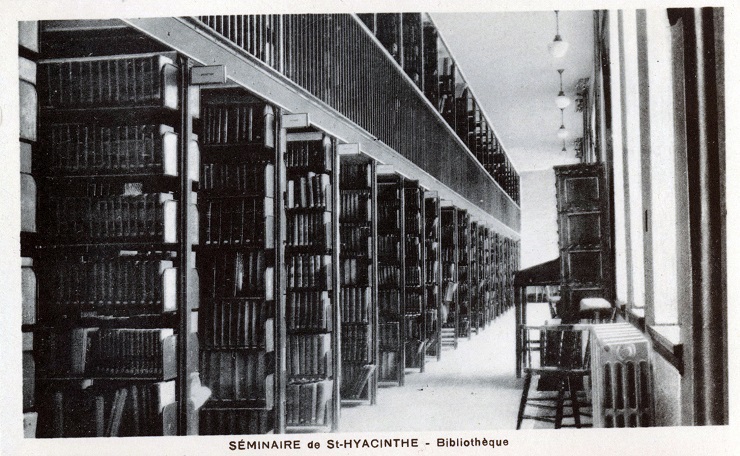
View in 1927, of the passage, the shelves and the mezzanine near the windows.
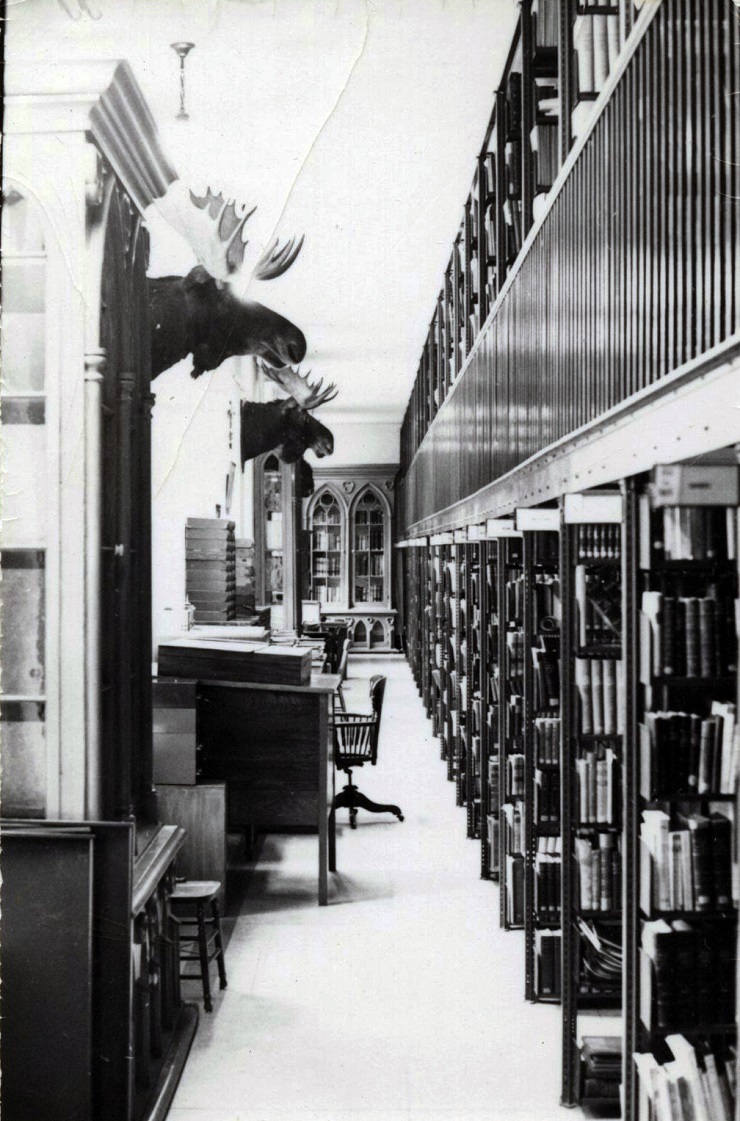
View in 1927, of the passage, the shelves and the mezzanine near the
windows.
You will remark the stuffed animals heads hnaged on the walls. Actually, we have
only keep the head of the deer.
The buffalo and the mooses heads were send to the Veterinay school of
Saint-Hyacinthe managed by the University of Montréal.
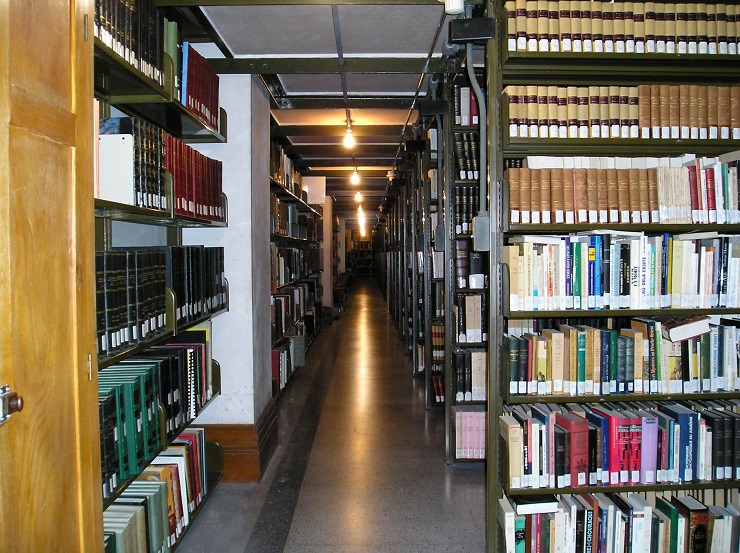
View of the shelves if you are near the inside wall on the ground level.
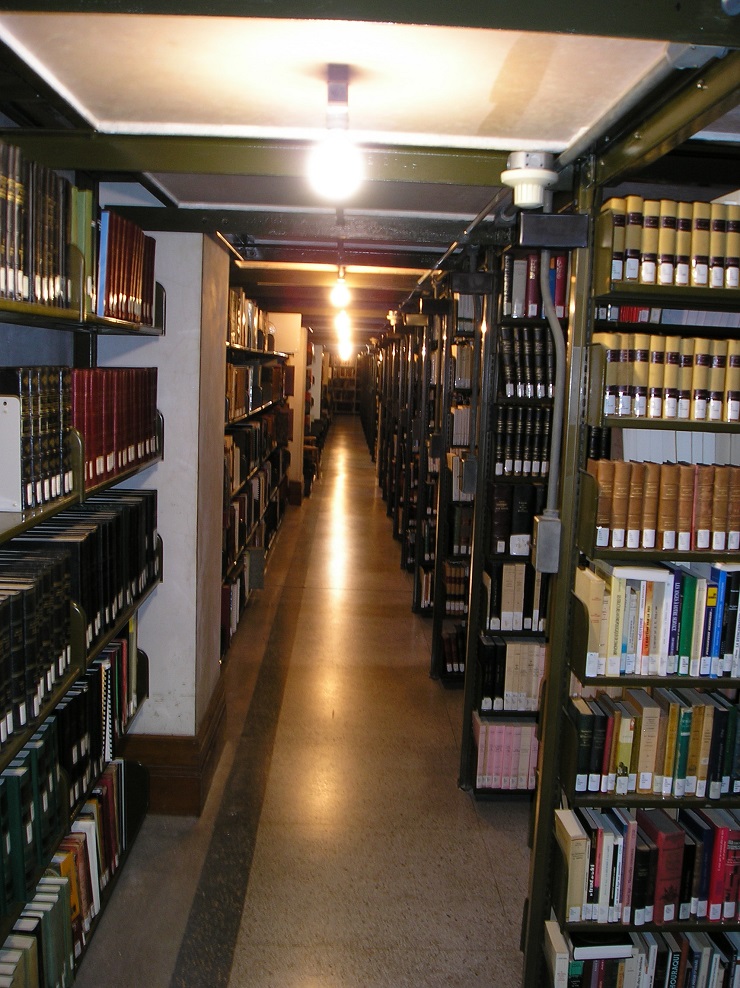
View of the shelves if you are near the inside wall on the ground level.
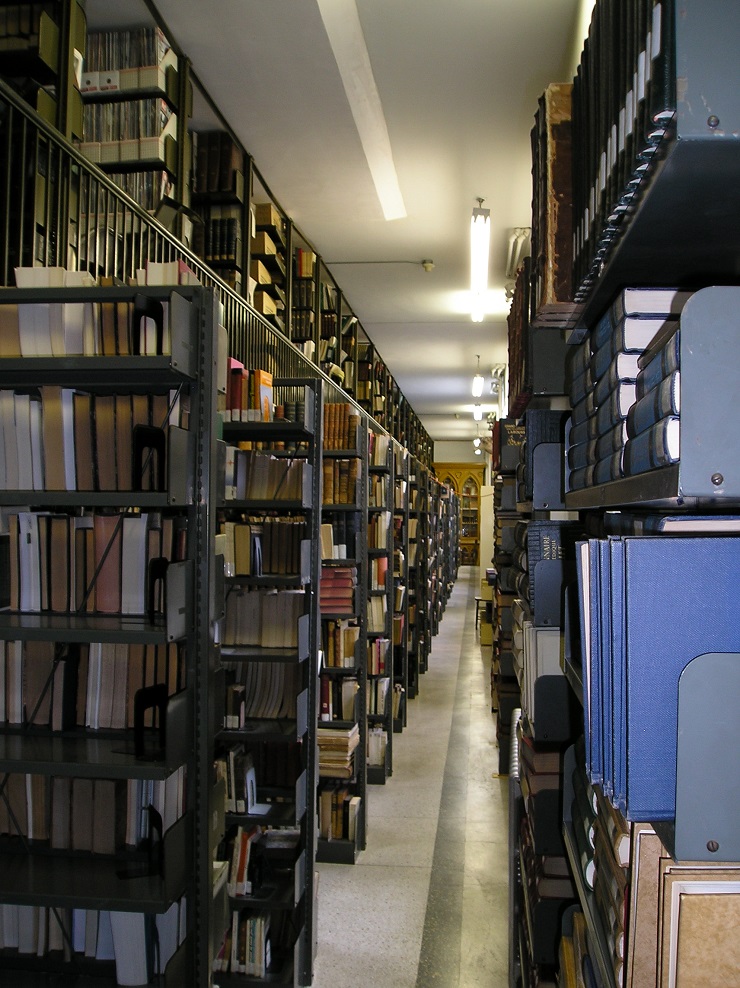
View in 2016, of the passage, the shelves and the mezzanine near the
windows.
The shelves actually displayed in the passage are from the library of the ancient
Great Seminary.
From 1927 to today, the position of the librarian was occupyed by many priests and few seculars. The library of the Seminary of Saint-Hyacinthe was opened only for the priests living at the Seminary. The students of the private school were not allowed to use this library. A small library was dedicated to the students. Until 1993, the library was restricted to everyone, you had to request a librarian's permission if you wanted to visit or to use it. Since 1993, the library is opened to the public. In 1991, the Seminary created a private corporation. That non-profit-making organization manages the daily library's operations. A professional librarian, Mr Bernard Auger, has been hired in 1993. His main goal is to computerize the collections who are in handwritten card files.





